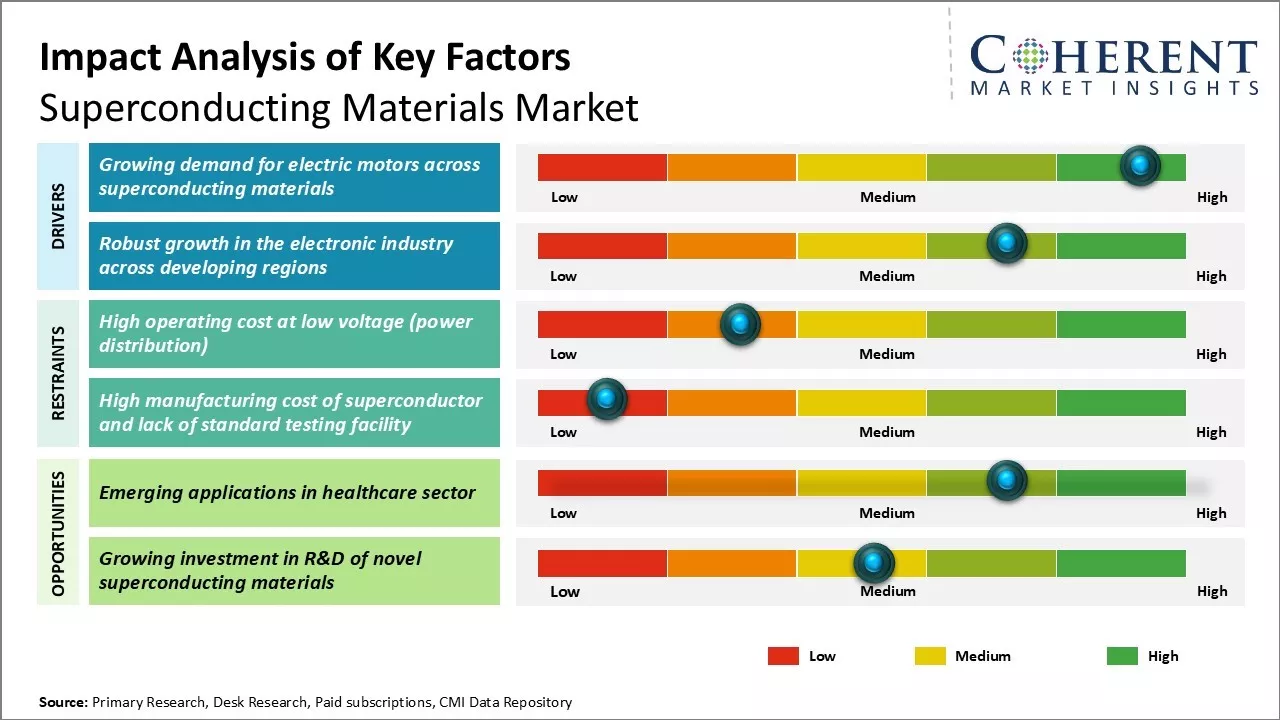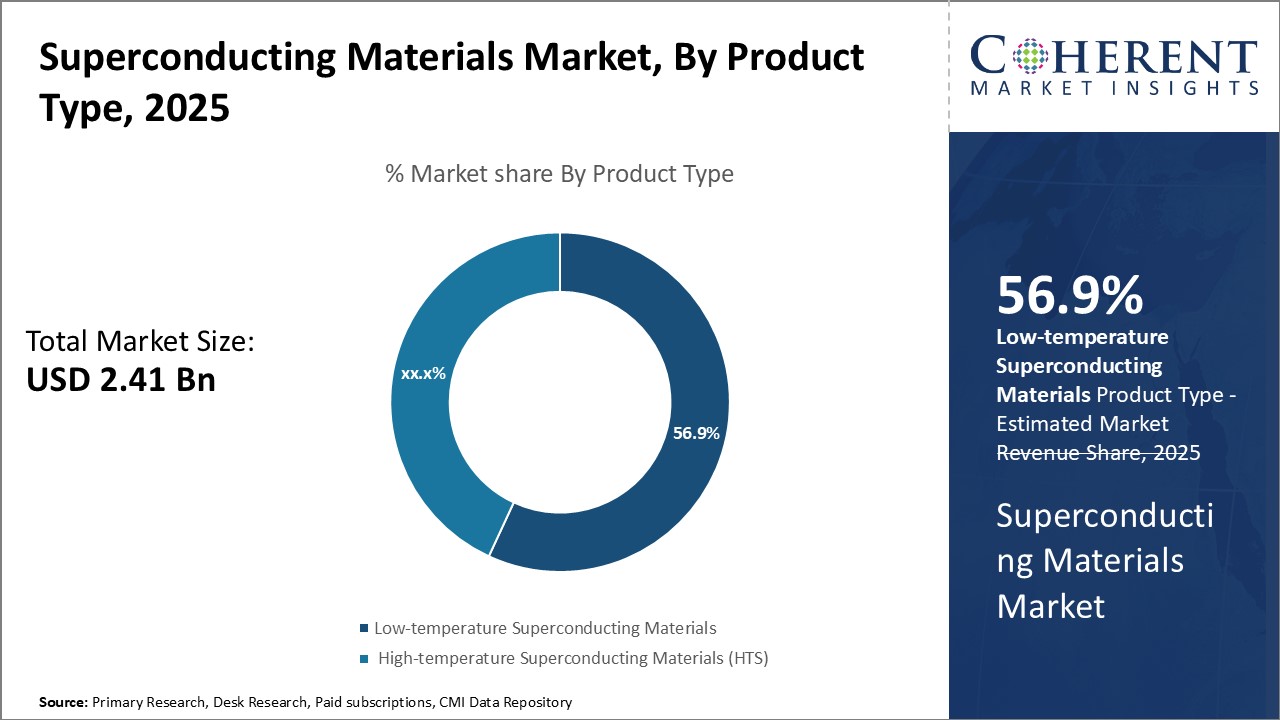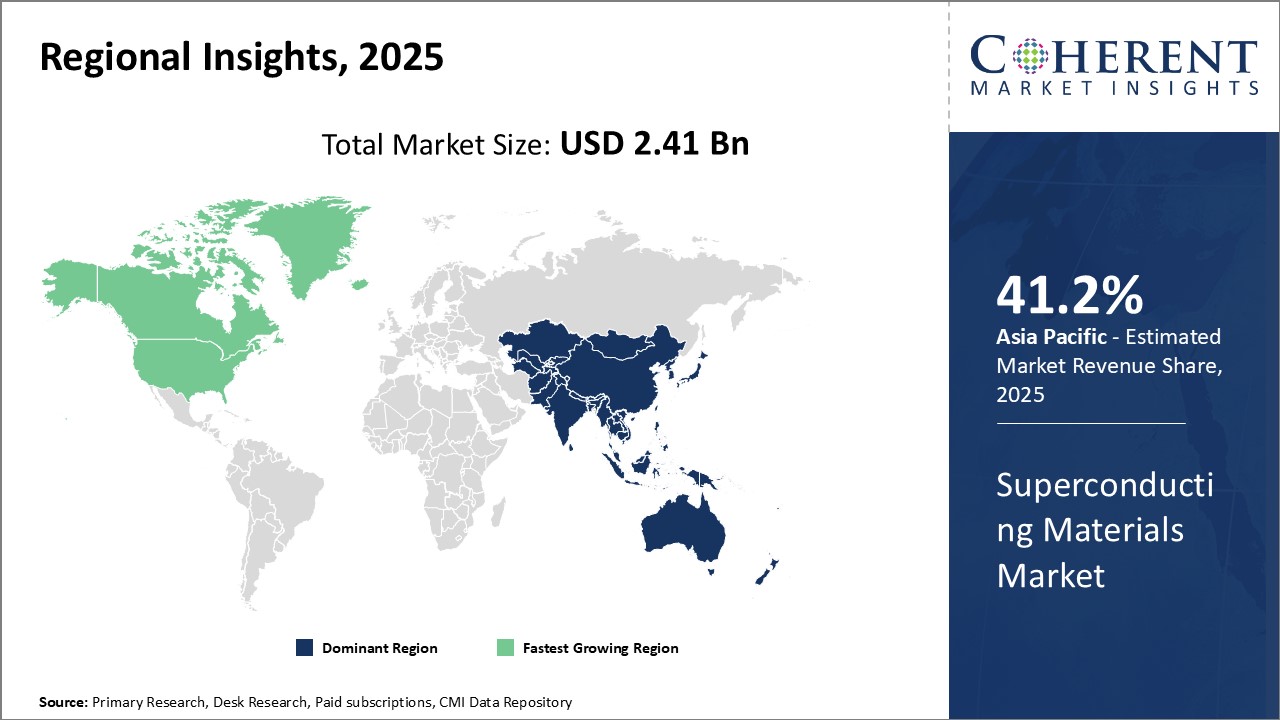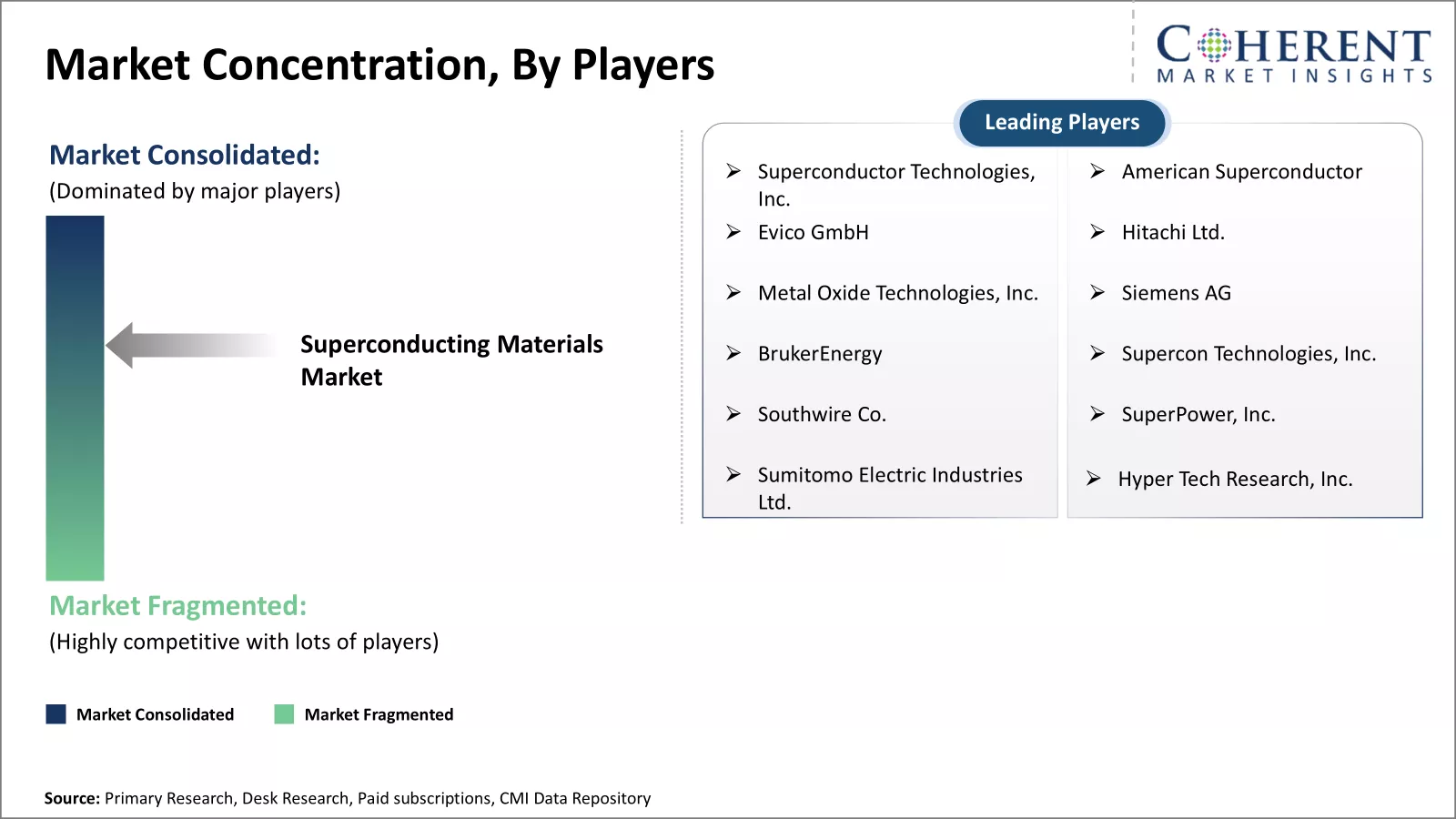Superconducting materials market is estimated to be valued at USD 2.41 Bn in 2025 and is expected to reach USD 4.55 Bn by 2032, exhibiting a compound annual growth rate (CAGR) of 9.5% from 2025 to 2032. Increasing demand from various end-use industries, such as healthcare, transportation, energy, and electronics, is driving the market growth.

Discover market dynamics shaping the industry: Download Free Sample
Superconducting materials market is expected to witness significant growth driven by growing emphasis on renewable energy generation along with rising investments in wireless charging technology. Additionally, increasing research & development activities to develop second generation high temperature superconducting materials is further expected to boost the demand for superconducting materials.

Discover high revenue pocket segments and roadmap to it: Download Free Sample
Insights, By Product Type: The Dominance of Low-temperature Superconducting Materials in Diverse Applications
In terms of product type, the low-temperature superconducting materials (LTS) segment is estimated to hold the highest market share of 56.9% in 2025, owing to its widespread applications. Low-temperature superconducting materials (LTS) have been widely used for decades due to their versatility and commercial availability. Many LTS can operate at temperatures achievable using liquid helium as a coolant, around 4K. This accessibility has allowed LTS to be integrated into various applications across multiple industries.
In the medical sector, LTS are commonly used in MRI machines to generate powerful magnetic fields for imaging. LTS-based MRI systems offer improved resolution and clarity compared to older technologies. Their stable magnetic fields also ensure reproducible, high-quality scans over the lifetime of the machines.
Insights, By End-Use Industry- The Critical Role of Superconducting Materials in Advancing Medical Technologies
In terms of end-use industry, the medical segment is estimated to contribute the highest market share of 38.7% in 2025 driven by the expanding needs for advanced diagnostic technologies.
Superconducting materials are essential components of advanced medical devices increasingly empowering earlier disease detection and more accurate diagnoses. Magnetic resonance imaging (MRI) machines rely on superconductors to generate strong magnetic fields, offering clearer, higher resolution images to aid identification of abnormalities. Superconducting quantum interference device (SQUID) sensors using superconductivity also augment diagnostics by enabling highly sensitive measurement of magnetic fields in the body.

Need a Different Region or Segment? Download Free Sample
Regional Analysis: Superconducting Materials Market
Dominating Region: Asia Pacific
Asia Pacific is expected to account for the greatest revenue share of 41.2% in 2025. This can be attributed to strong government funding for research and development activities in countries such as China. Established industry players such as DuPont have invested heavily in developing commercially viable superconducting materials, boosting regional adoption across industries like healthcare, transportation, and energy.
Fastest-Growing Region: North America
The North America region exhibits the fastest growth, driven by growing electronics manufacturing industry and increasing investments by countries like the U.S. and Canada to expand the renewable energy infrastructure. Notable industry participants such as Fujikura have established R&D centers and production facilities in the region to capitalize on the burgeoning demand.
Superconducting Materials Market Outlook for Key Countries
U.S.: The U.S. market continues to benefit from collaborations between leading academic research institutions and commercial entities to develop applications of superconducting materials.
China: China market remains a major global force with government-backed initiatives to deploy super grids and high-speed rail networks.
India: India market continues to lead renewable energy expansion in South Asia through initiatives like the International Solar Alliance.
Japan: Japan market sees support from heavyweights including Hitachi that integrate superconducting solutions across business divisions to boost efficiency.

Get actionable strategies to beat competition: Download Free Sample
Top Strategies Followed by Superconducting Materials Market Players
Emerging Startups in the Superconducting Materials Market
Some innovative startups are bringing revolutionary technologies. Quantum Connex develops quantum dot architectures using atom-thin superconducting materials for ultrafast quantum computing. Their R&D could enable 100x faster, low power computing circuits crucial for applications in AI, drug discovery and autonomous vehicles.
Sustainability is a priority for startups like Phoenix Materials. They extract rare earths and precious metals from e-waste to manufacture eco-friendly superconductors, slashing carbon footprint by 70%. Such closed-loop production addresses the environmental impact of mining while producing high-quality materials.
Other startups fill vital market gaps. Suprapolymers focuses on developing superconducting polymers and gels suited for flexible electronics, medical implants and wearables.
Key Takeaways from Analyst
Superconducting Materials Market Report Coverage
| Report Coverage | Details | ||
|---|---|---|---|
| Base Year: | 2024 | Market Size in 2025: | USD 2.41 Bn |
| Historical Data for: | 2020 To 2024 | Forecast Period: | 2025 To 2032 |
| Forecast Period 2025 to 2032 CAGR: | 9.5% | 2032 Value Projection: | USD 4.55 Bn |
| Geographies covered: |
|
||
| Segments covered: |
|
||
| Companies covered: |
Superconductor Technologies, Inc., American Superconductor, Evico GmbH, Hitachi Ltd., Metal Oxide Technologies, Inc., Siemens AG, BrukerEnergy, Supercon Technologies, Inc., Southwire Co., SuperPower, Inc., Sumitomo Electric Industries Ltd., and Hyper Tech Research, Inc. |
||
| Growth Drivers: |
|
||
| Restraints & Challenges: |
|
||
Uncover macros and micros vetted on 75+ parameters: Get instant access to report
Market Driver - Growing demand for electric motors across superconducting materials
The rising adoption of electric motors across various end-use industries has been propelling the demand for superconducting materials significantly. With governments emphasizing on emission reduction and sustainable development, electric motors have emerged as an eco-friendly substitute to conventional internal combustion engines. Superconducting materials such as Yttrium barium copper oxide YBCO and Bi-2212 find widespread applications in designing electric motors meant for heavy industrial machinery, manufacturing plants, transportation systems and critical infrastructure.
For instance, in July 2023, according to the International Energy Agency, the global shift towards more efficient electric motor systems using superconductors can potentially reduce annual energy usage by over 1000 TWh by 2030. As more energy end uses become electrified, the share of electricity in total final energy consumption increases in the Net Zero Emissions by 2050 (NZE) Scenario from 20% in 2022 to over 27% in 2030. Additionally, superconducting electric motors occupy only 1/10th space of conventional motors of equivalent power capacities.
Market Challenge - High operating cost at low voltage (power distribution)
The high operating costs associated with low voltage power distribution is one of the major factors restraining the growth of the superconducting materials market. Superconducting materials need to be cooled to very low temperatures, near absolute zero, to exhibit superconducting properties. This requires large amounts of energy to power refrigeration units that can achieve such low temperatures. Maintaining these extremely low operating temperatures on a continuous basis consumes huge amounts of electricity.
For instance, the refrigeration systems used to cool superconducting materials down to their operating temperatures of below -200°C need to constantly pump out heat from within. This cooling process places a heavy demand on energy sources. Studies by the International Energy Agency (IEA) in 2020 found that the electricity required for such vigorous cooling accounted for over 30% of total operating costs in some early prototype applications of superconductivity. With electricity costs rising year-on-year, the operating expenses involved in maintaining endlessly low temperatures has proven prohibitively expensive for many potential commercial uses of superconductivity.
Market Opportunity - Emerging applications in healthcare sector
The superconducting materials market is poised to see major growth opportunities arising from emerging applications in the healthcare industry. Devices like Magnetic Resonance Imaging (MRI) machines, which use superconducting magnets to generate strong magnetic fields, are seeing increasing demand globally driven by rise in non-communicable diseases and aging populations. These devices could enable minimally invasive surgery with greater control and precision. With no friction involved, superconducting tools may allow surgeons to navigate narrow blood vessels and perform complex procedures much more effectively than previously possible. This has potential to reduce surgery times, lower risks of complications, and speed recovery for patients. Trials show superconducting catheters can reach sites conventional devices cannot. For instance, in September 2023, according to the World Health Organization (WHO), minimally invasive procedures reduce trauma and hospital stays, leading to better clinical outcomes and economic benefits for health systems.
Share
Share
About Author
Vidyesh Swar is a seasoned Consultant with a diverse background in market research and business consulting. With over 6 years of experience, Vidyesh has established a strong reputation for his proficiency in market estimations, supplier landscape analysis, and market share assessments for tailored research solution. Using his deep industry knowledge and analytical skills, he provides valuable insights and strategic recommendations, enabling clients to make informed decisions and navigate complex business landscapes.
Missing comfort of reading report in your local language? Find your preferred language :
Transform your Strategy with Exclusive Trending Reports :
Frequently Asked Questions
Joining thousands of companies around the world committed to making the Excellent Business Solutions.
View All Our Clients